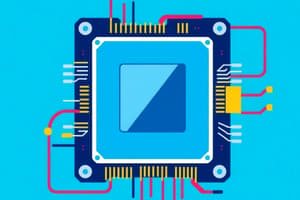Podcast
Questions and Answers
What is the primary purpose of networking?
What is the primary purpose of networking?
- To provide entertainment for users
- To secure electronic information
- To manage hardware devices
- To facilitate information sharing among users (correct)
Which of the following is NOT a key aspect of cybersecurity?
Which of the following is NOT a key aspect of cybersecurity?
- Maintaining firewalls
- Securing passwords
- Installing anti-virus software
- Developing new programming languages (correct)
Which category of software includes popular productivity tools like Microsoft Office?
Which category of software includes popular productivity tools like Microsoft Office?
- Programming languages
- Utility software
- Operating systems
- Application software (correct)
Which programming language is considered an object-oriented language?
Which programming language is considered an object-oriented language?
Which networking technology uses satellite connections?
Which networking technology uses satellite connections?
Which of the following is NOT a key responsibility of cybersecurity professionals?
Which of the following is NOT a key responsibility of cybersecurity professionals?
What is the primary function of the central processing unit (CPU) in a computer?
What is the primary function of the central processing unit (CPU) in a computer?
Which of the following is a type of network that allows computers to communicate and share resources within a limited geographical area?
Which of the following is a type of network that allows computers to communicate and share resources within a limited geographical area?
Which component of a computer is responsible for providing temporary storage during computations?
Which component of a computer is responsible for providing temporary storage during computations?
What is the primary purpose of cybersecurity measures in computer systems?
What is the primary purpose of cybersecurity measures in computer systems?
Which component of a computer system is responsible for user interaction through input and output devices?
Which component of a computer system is responsible for user interaction through input and output devices?
What is the primary function of programming languages in computer systems?
What is the primary function of programming languages in computer systems?
Flashcards are hidden until you start studying
Study Notes
Computer
A computer is an electronic device designed to manipulate information, perform calculations, and execute instructions from a program. It consists of various components that work together to enable users to input data, process it using software, store results, and display them through output devices. In this context, we will discuss computers based on their hardware, networking capabilities, security features, software applications, and programming languages.
Hardware
Hardware refers to the physical parts of a computer system, including the central processing unit (CPU), memory, storage devices, input/output devices, peripherals, and interconnecting hardware. Each component plays a crucial role in ensuring the computer operates efficiently. The CPU, also known as the brain of the computer, executes complex instructions and coordinates other components' activities. Memory stores temporary data during computation, while storage devices such as hard drives and solid-state drives provide permanent storage for programs and files. Input/output devices enable user interaction through keyboards, monitors, and printers, while peripherals extend the functionality of a computer system.
Networking
Networking allows computers to communicate and share resources with one another, forming a network. It involves the creation of communication pathways between computers, which can include local area networks (LANs), wide area networks (WANs), and the Internet. The primary purpose of networking is to facilitate information sharing among users, providing them with opportunities to collaborate, exchange ideas, and perform tasks more effectively. Networking technologies include Wi-Fi, Bluetooth, fiber-optic cables, and satellite connections.
Cybersecurity
Cybersecurity focuses on protecting electronic information from unauthorized access, modification, and destruction. It encompasses essential practices such as securing passwords, installing anti-virus software, and maintaining firewalls. Computer security helps prevent cyber attacks, safeguard sensitive data, and protect systems against malware and hackers. Additionally, cybersecurity measures ensure compliance with regulations and promote trust between organizations and their clients. Various job roles within cybersecurity include security analysts, security architects, and incident responders.
Software
Software refers to programs designed to run on computers and operate on specific platforms. Software applications fall broadly into three categories: operating systems (OS), application software, and utility software. Operating systems like Windows 10, macOS, and Ubuntu handle basic tasks and provide a platform for running other software. Application software includes popular productivity tools such as Microsoft Office, Adobe Creative Suite, and LibreOffice. Utility software assists with computer maintenance, such as disk cleanup or virus scanning tools like Avira.
Programming
Programming involves writing instructions for computers to execute specific tasks. It requires knowledge of programming languages, which can be categorized based on their syntax and purpose. Examples include procedural languages (such as C++), object-oriented languages (Java), functional languages (Python), and scripting languages (JavaScript). Each language has its strengths and applications, making them suitable for different scenarios. Additionally, programmers must possess problem-solving skills to break down complex problems into manageable steps.
In conclusion, understanding the hardware, networking, cybersecurity, software, and programming aspects of computers is crucial for effectively utilizing these devices and ensuring security and efficiency within organizations. As technology continues to evolve, staying informed about advancements in these areas will remain essential for users and professionals alike.
Studying That Suits You
Use AI to generate personalized quizzes and flashcards to suit your learning preferences.




